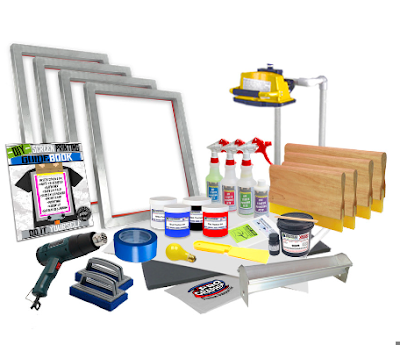Screen Printing Supplies: Essential Tools for Custom Apparel Printing
Screen printing is a popular method used for customizing apparel, creating vibrant designs, and producing high-quality prints. Whether you're a professional screen printer or a DIY enthusiast, having the right screen printing supplies is essential to achieve excellent results. In this article, we will explore the essential tools and supplies needed for screen printing, from screens and inks to squeegees and emulsion, helping you understand the key components required for successful screen printing projects.
- Screens:
Screens are one of the fundamental elements in screen printing. They consist of a mesh stretched over a frame, and they serve as the foundation for transferring the design onto the substrate. When choosing screens, consider factors such as mesh count, screen size, and frame material. Mesh count refers to the number of threads per inch and determines the level of detail and ink deposit in the print.
- Emulsion and Screen Prep:
Emulsion is a light-sensitive substance that forms a stencil on the screen. It allows the ink to pass through the designated areas while blocking it from unwanted areas. Properly preparing screens with emulsion is essential for achieving clean and sharp prints. Screen prep supplies, such as degreasers and emulsion removers, are used to clean and reclaim screens after use.
- Squeegees:
Squeegees are used to push the ink through the screen and onto the substrate. They come in various sizes and hardness levels. When selecting a squeegee, consider the type of ink being used and the desired print result. Harder squeegees are suitable for thicker inks and more substantial coverage, while softer squeegees are ideal for thinner inks and finer details.
- Inks:
Inks are available in different formulations, such as plastisol, water-based, and discharge. Plastisol inks are the most common and versatile, providing vibrant colors and excellent opacity. Water-based inks offer a softer feel and are environmentally friendly, while discharge inks remove the dye from dark-colored fabrics for a unique, soft-hand print. Choose inks based on the desired effect, fabric type, and personal preference.
- Exposure Unit or Light Source:
To transfer your design onto the screen, you'll need an exposure unit or a light source. An exposure unit uses UV light to cure the emulsion, creating a durable stencil. Alternatively, a light source, such as a high-wattage halogen light, can be used along with a darkroom setup to achieve the same result.
- Printing Press or Setup:
A printing press or setup provides stability and consistency during the printing process. There are various options available, ranging from manual tabletop presses to automated machines. The choice depends on the volume of printing, the complexity of designs, and budget considerations. A stable setup ensures accurate registration and smoother printing.
- Heat Source for Curing:
Once the ink is applied to the substrate, it needs to be cured to ensure durability and washability. A heat source, such as a conveyor dryer or heat press, is required to cure plastisol inks. Water-based inks typically require heat curing as well, although lower temperatures may be sufficient.
- Cleaning and Reclaiming Supplies:
Proper cleaning and maintenance of screens and tools are essential to prolong their lifespan. Screen cleaning supplies, such as screen washes, haze removers, and emulsion removers, help remove ink and residue, keeping the screens in optimal condition. Reclaiming supplies, like stencil removers and reclaiming chemicals, aid in stripping the emulsion for screen reuse
- Mesh
The mesh is the material that is stretched over the frame to create the screen. The mesh's thread count and thickness can vary, depending on the type of print you are making. The mesh's thread count determines the number of ink colors that can be used in the print.
- Dryer
After the ink has been applied to the material, it needs to be dried before it can be used or sold. A dryer is used to dry the ink, and it can be a simple tabletop unit or a large industrial dryer.
In conclusion, the screen printing process requires various supplies, and having the right ones is crucial to getting high-quality results. These supplies can be found at most art and craft stores or online retailers. Make sure to choose high-quality supplies to ensure that your prints come out looking great and are durable enough to last.

